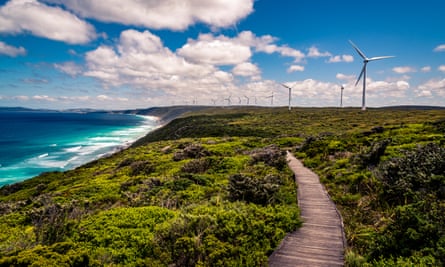Climate policy experts say Australia needs to set a more ambitious 2030 climate commitment to reach a carbon neutral economy

Last modified on Tue 10 Nov 2020 12.04 AEDT
Australia could become a carbon neutral economy by 2050 thanks to an abundance of cheap solar and wind energy but will need a more ambitious 2030 climate target to get there, according to a report from international climate policy experts.
A path to net zero emissions is technically and economically feasible for Australia, the report says, and would align the country with the Paris climate agreement it signed in 2016.
Such a transition would create tens of thousands of new jobs in the renewable energy industry and “future-proof” the country from economic shocks as the rest of the world moved away from fossil fuels.
The report, from Climate Action Tracker (CAT), used two different models covering climate policies and energy systems to find out how the country could reach net zero emissions by 2050.
Many of Australia’s key trading partners, including those currently purchasing most of the country’s coal and LNG exports, have endorsed a net zero target by 2050, including Japan and South Korea.
China, the world’s biggest emitter, has said it will balance its emissions to zero by 2060.
US president-elect Joe Biden has made cutting emissions a key priority for his administration, saying the country will reach net zero by 2050 with 100% renewable electricity by 2030.
Reaching net zero means that a country’s greenhouse gas emissions from activities such as fossil fuel burning and mining are balanced by the uptake of carbon in soils, forests or by technologies like carbon capture and storage.
The Morrison government has refused to budge on its current targets and has said only that it will aim to reach net zero by the second half of this century, a position some experts say is at odds with the Paris agreement.
A lead author on the CAT report, Ursula Fuentes Hutfilter, a senior climate policy adviser at Climate Analytics, told Guardian Australia: “The biggest missing piece [for Australia] is to have a consistent approach across the economy.
“That means setting a net zero target for 2050 and then working backwards to see how fast each sector needs to transition.
“Once you have a 2050 target and you look at how you get there, what you then see is that you have to then enhance the 2030 target.”
Australia’s 2030 target to cut emissions by 26%-28% from 2005 levels has remained the same since it was first announced by the Abbott government in 2015.
The CAT report says Australia’s 2030 target should be raised to 66% below 2005 levels, which is at the high end of the range recommended in 2014 by the government’s Climate Change Authority.
Fuentes Hutfilter said: “So many of the policies that have proven to be effective in similar places are not in place in Australia, but if they were it could escalate the transition. It is hard to find a country where the policy gap is so large.”
She said policies such as a national renewable energy target, emissions standards in the transport sector, support for electric vehicles and energy efficiency incentives in industry were all policy levers being pulled by other developed countries that were absent in Australia.
In the electricity sector, coal was the dirtiest power source and would need to be phased out by 2030.
The CAT modelling also shows that gas, which currently delivers about 20% of Australia’s electricity, would drop to about 3% by 2030 and be gone by 2040.
The Morrison government has flagged a gas-fired recovery from the Covid-19 pandemic, saying the fossil fuel compliments renewables by “keeping the lights on when the sun isn’t shining and the wind isn’t blowing”.
But the CAT report says technologies including battery storage and pumped hydro, as well as better management of electricity demand, would mean gas-fired electricity would not be needed.
Fuentes Hutfilter said: “Renewable energy technologies are the cheapest, and that’s why the modelling shows [gas phasing out].
“Storage technologies are developing with costs falling fast, so all the technologies needed are already in place. There’s no need to add gas.
“We know coal will be declining anyway because Australia has an old coal fleet that’s becoming increasingly unreliable.”
She said Australia’s potential to generate energy from renewable sources was “immense” and the country could export that renewable energy embedded in products, including green hydrogen.
An essential component to reach net zero, the CAT report finds, is to end deforestation by the year 2030.
Stopping deforestation and allowing trees and soils to take up more carbon would reduce reliance on other technologies, such as carbon capture and storage, to balance the country’s carbon budget.
One of the most challenging industries to decarbonise would be Australia’s export-focused LNG sector, and carbon capture and storage may be needed there to meet a net zero target.
Australia’s current policies were failing to deliver sufficient greenhouse gas reductions across the transports and industry sectors and were only just getting started in electricity generation.
The report found current policies would create 25,600 direct jobs in power generation, but shifting to policies in line with the Paris goals that emphasised local manufacturing would deliver 62,300 direct jobs.
No comments:
Post a Comment